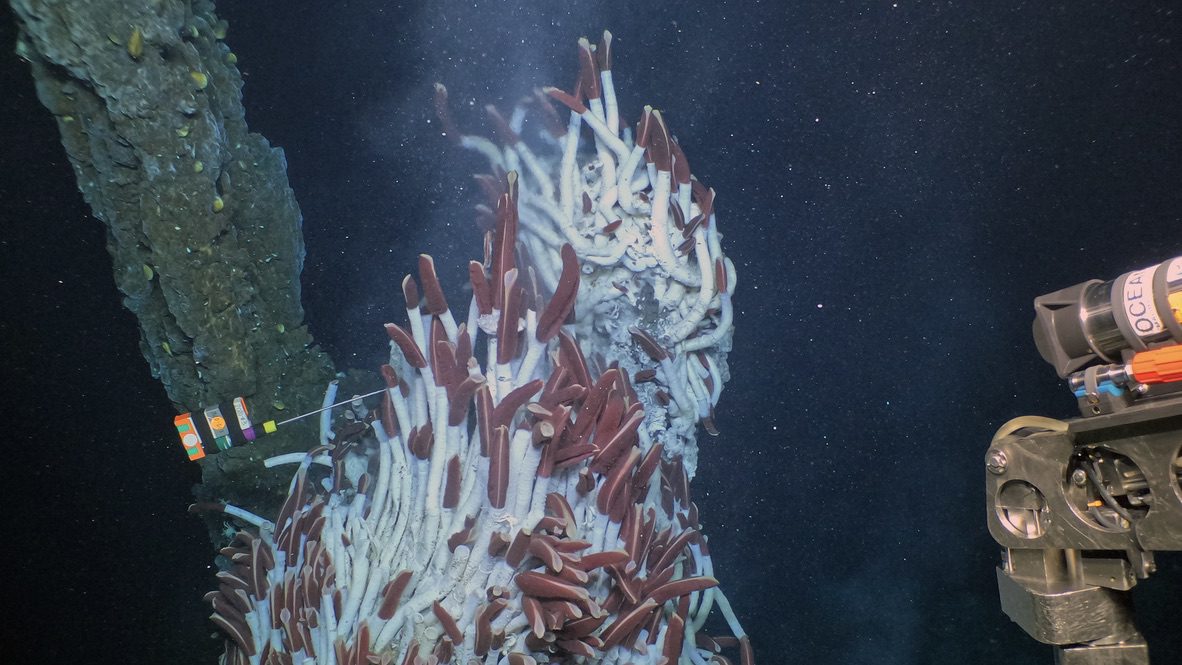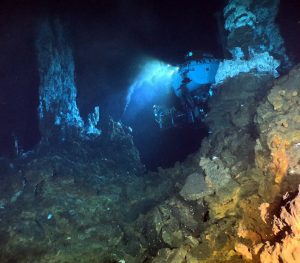Scientists uncover a new way to forecast eruptions at mid-ocean ridges through hydrothermal vent temperatures
 Data loggers deployed at hydrothermal vents on the East Pacific Rise record temperature of vent fluids every ten minutes for up to a year. (Photo courtesy of Photo courtesy of Jill McDermott, Lehigh Univ.; WHOI, NDSF, Alvin Team; Funder: National Science Foundation. © Woods Hole Oceanographic Institution)
Data loggers deployed at hydrothermal vents on the East Pacific Rise record temperature of vent fluids every ten minutes for up to a year. (Photo courtesy of Photo courtesy of Jill McDermott, Lehigh Univ.; WHOI, NDSF, Alvin Team; Funder: National Science Foundation. © Woods Hole Oceanographic Institution) October 13, 2025
Woods Hole, Mass (October 13, 2025) -- A new study published in the Proceedings of the National Academy of Sciences (PNAS) provides scientists with a powerful new tool for monitoring and predicting tectonic activity deep beneath the seafloor at mid-ocean ridges—vast underwater mountain chains that form where Earth’s tectonic plates diverge.
The study, titled “Hydrothermal vent temperatures track magmatic inflation and forecast eruptions at the East Pacific Rise, 9°50'N,” reveals that fluctuations in the temperature of fluids flowing from hydrothermal vents occurring over minutes to years indicate the effects of magmatic and tectonic processes that occur miles beneath the seafloor. The research offers the first evidence that these subtle but detectable temperature changes could offer the means to predict seafloor volcanic eruptions.
Led by Thibaut Barreyre of the French National Centre for Scientific Research (CNRS) and University of Brest, with collaborators from Woods Hole Oceanographic Institution (WHOI), Lehigh University, and Scripps Institution of Oceanography, the study presents a 35-year time-series of temperature measurements from five hydrothermal vents along the East Pacific Rise, one of the most active segments and well-studied of the global mid-ocean ridge system.
“Mid-ocean ridges are where much of Earth’s internal thermal energy is transferred to the ocean,” said Dan Fornari, scientist emeritus at WHOI and a co-author on the study. “Until now, we lacked a direct way to link what we can measure at the seafloor to what’s happening deep below, where magma accumulates and drives eruptions. Our results show that the two are intimately connected.”
Hydrothermal vents form when seawater seeps into oceanic crust, heats as it interacts with the underlying rock, and re-emerges at locations known as hydrothermal vents, often reaching temperatures above 350°C (660°F). These vents help maintain Earth’s thermal balance and support unique ecosystems that thrive in the absence of sunlight.
The long-term dataset used by the team—one of the most continuous and comprehensive of its kind ever assembled—revealed that vent temperatures at the East Pacific Rise rose steadily from around 350°C to nearly 390 °C in the years preceding two known eruptions, in 1991–1992 and 2005–2006. Following the latter event, temperatures dropped back to about 350°C but have been climbing ever since.
The authors suggest that this temperature increase is driven by rising pressure in the oceanic crust, itself caused by the gradual increase of magma located roughly one mile beneath the seafloor. As the magma body expands, it pressurizes surrounding rock as well as the hydrothermal fluids they contain, a process detectable as a slow but steady warming at the vent outlets.
“By combining these temperature measurements with analytical models and seafloor data, we found that vent heating correlates with the buildup of magmatic pressure,” said Barreyre. “That’s a clear signal that can help us anticipate eruptions before they occur.”
Indeed, the team’s analysis indicated conditions consistent with an imminent eruption in early 2025—a forecast that proved accurate when a mid-ocean ridge eruption was confirmed in April by a team using the human-occupied submersible Alvin that included many of the co-authors. This marks one of the first times scientists have successfully predicted a deep-sea volcanic event based on hydrothermal data.

The human-occupied vehicle Alvin, during a dive on the East Pacific Rise, collected samples and recovered instruments placed at the vents during previous expeditions. (Photo courtesy of Jill McDermott, Lehigh Univ.; WHOI, NDSF, Alvin Team; Funder: National Science Foundation. © Woods Hole Oceanographic Institution)
The findings hold promise for advancing global ocean monitoring networks along mid-ocean ridges and for improving understanding of how Earth’s interior interacts with the ocean. With long-term autonomous instruments now capable of continuously tracking seafloor conditions, scientists are closer than ever to “listening” to the planet’s tectonic heartbeat in near-real time.
“This is an extraordinary step forward in submarine geophysics,” said Fornari. “Hydrothermal vents are not just biological oases—they are windows into the dynamic processes that shape our planet.”
Research funded by NSF Grants OCE-1834797, OCE-1949485, OCE-194893, OCE-1949938, OCE-1948936; the Agence Nationale de la Recherche (ANR) Grant ANR-24-CE56-6841-01 (Project OMENS); the Centre National de la Recherche Scientifique (CNRS); and the European Research Council (ERC) under Grant Agreement No. 10117070619 (Project SeaSALT).
###
About Woods Hole Oceanographic Institution
Woods Hole Oceanographic Institution (WHOI) is a private, non-profit organization on Cape Cod, Massachusetts, dedicated to marine research, engineering, and higher education. Founded in 1930, its mission is to understand the ocean, its interactions with the Earth, and its role in a changing global environment. WHOI’s pioneering discoveries arise from a unique blend of science and engineering that has made it one of the world’s most trusted leaders in ocean research and exploration. Known for its multidisciplinary approach, advanced ship operations, and unmatched deep-sea robotics, WHOI also operates the most extensive suite of ocean data-gathering platforms worldwide. More than 800 concurrent projects—driven by top scientists, engineers, and students—push the boundaries of knowledge to inform people and policy for a healthier planet. Behind the scenes, ship captains, mates, craftsmen, marine operations, and other skilled professionals provide essential support that makes this work possible. Learn more at whoi.edu.
